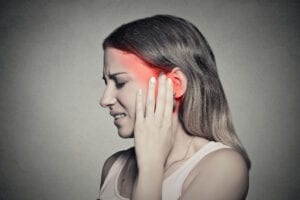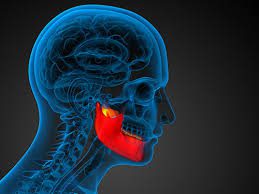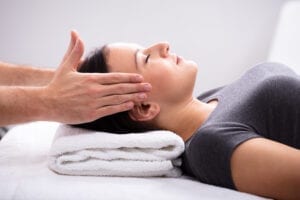Ear/Jaw Pain, Headaches & Dizziness Can Come From Clenching Your Teeth?
Recently in the clinic we are seeing more and more patients with complaints of ear/jaw pain as well as headaches and a sense of dizziness. Your jaw, also known as your temporomandibular joint (TMJ), can be a significant source of these symptoms if there is a joint dysfunction or a muscle imbalance.

Women experiencing ear/jaw pain due to TMJ dysfunction.
Increased stress, decreased postural awareness and/or a poor ergonomic work station setup can contribute to increased clenching of the jaw, which can result in muscle tightness and faulty joint mechanics. With more people working from home and additional stresses placed on individuals during these times of social distancing, it’s important to increase awareness on how stress, posture and ergonomics can contribute to headaches, ear/jaw pain and dizziness.
If you are slouching while you are sitting you will notice that your tongue is not resting on the roof of your mouth, this causes stress in your TMJ and often results in clenching your teeth. If you correct your posture and sit up straight, your tongue will rest on the roof of your mouth alleviating the tension in your jaw. If your tongue is touching the roof of your mouth, is the proper resting position of your tongue. Try it!
This is just another reason why your posture and ergonomics (how you set up your computer or work station) at home is so important. Poor posture and ergonomics contributes to so much more than low back and neck pain!
A Few Symptoms Associated with TMJ Dysfunction Include;

Temporomandibular Joint Pain
- Headaches or ear pain upon waking in the morning
- Temporal headaches – ranging from mild ache to stabbing pain
- Tension type headaches – begin at the base of the skull radiating to the forehead
- Restricted or painful motion in your jaw
- Clicking with opening and closing of your jaw
- Jaw, ear, or facial pain
- Dizziness, headaches, or jaw/ear pain with chewing
Helpful Tips
- Be aware of your posture – don’t slouch
- Don’t grind your teeth or clench your jaw
- Don’t chew gum
- Learn relaxation techniques to decrease clenching during stressful periods
- Adjust your computer or work station so that you are not reaching for your keyboard or mouse; in order to assist with good postural habits and no slouching!
Specialized physical therapy intervention can assist in alleviating symptoms associated with TMJ dysfunction. A few key techniques and methods that may be utilized during intervention include the following:

Therapist Performing Myofascial Release To Woman With TMJ Dysfunction
Soft Tissue Mobilization/Myofascial Release: Increased muscle tone (tightness) or muscle spasm resulting from clenching the jaw may compress small nerves; contributing to symptoms of temporal pain/headaches. Mal occlusion of the jaw may result in abnormal nerve stimulation, which causes certain muscle in your neck to get tight.
Headaches may then begin at the base of your skull and radiate into your forehead. Muscles in the front of your neck that connect behind your ear may get tight, resulting in ear fullness or pressure as well as ear pain. There are multiple techniques utilized to decrease muscle tightness and improve flexibility in these muscles.
Joint Mobilization/Muscle Energy Techniques: Decreased joint mobility or altered joint mechanics in your neck or jaw may result in pain or headaches. Treatment for this is achieved through gentle joint mobilizations and muscle energy techniques. Joint mobilizations are pain free, non-aggressive techniques that improve the joint mechanics. Joint mobility is promoted throughout the jaw and cervical spine, as restrictions in these areas may contribute to your problem. Muscle energy techniques are a gentle way to influence your jaw mechanics and increase mobility by having you contract and relax muscles in a specific way.
Strength & Cervical Stabilization: Proper joint mechanics in the cervical spine and jaw depend on muscle strength and tension relationships. When muscles are too weak or too tight more stress is placed on the jaw as well as cervical ligaments and joint capsules. Tightening or shortening of the neck muscles can result in faulty jaw mechanics, which may cause pain and wearing away of the joint surfaces.
Education is provided on postural correction, proper ergonomics, body mechanics and exercises related to TMJ dysfucntion and cervical issues.
Evaluation by an oral surgeon may be required if the problem is complex and not manageable with physical therapy.
Physical Therapy Rehabilitation Services
If you are searching for relief of jaw/ear pain, tension or cervicogenic headaches or dizziness then skilled Physical Therapy intervention is a highly effective non-surgical treatment option to improve or resolve your condition. Physical therapists are like body mechanics and can help to find the mechanical cause of your pain. A skilled therapist will perform a comprehensive evaluation to assess all factors contributing to your condition.
It’s time to act and reduce or eliminate your pain, call to schedule an appointment with a physical therapist today. Your therapist will develop a personalized treatment plan based on your evaluation findings to target your specific needs. Balance Solutions Physical Therapy is here to help, offering advanced physical therapy and manual therapy intervention for pain relief.
Balance Solutions Physical Therapy is located at Commerce Park in Beachwood Ohio, just on the outskirts of Cleveland. Services offered include physical therapy, massage, myofascial release, Integrative Dry Needling, as well as Pilates mat and reformer private and class lessons.

